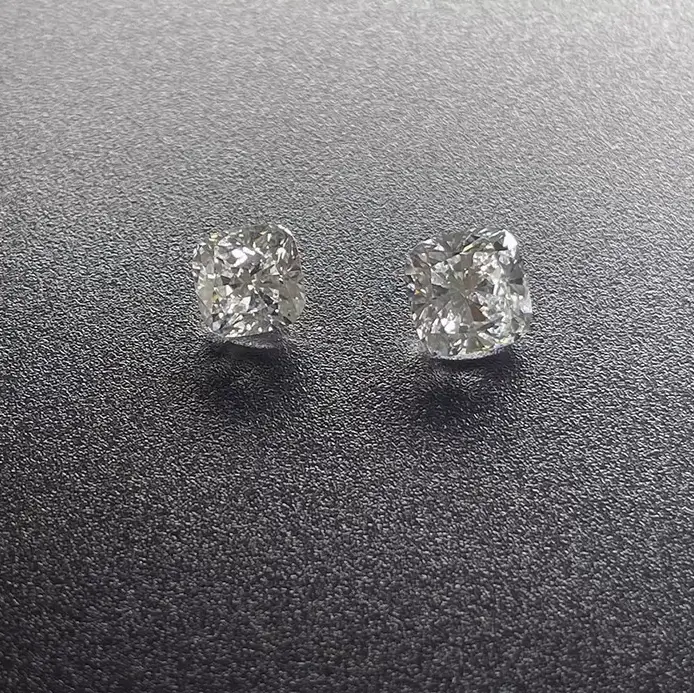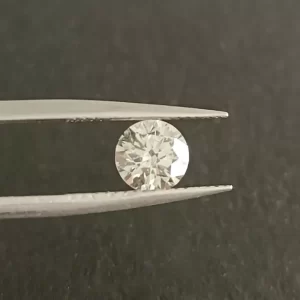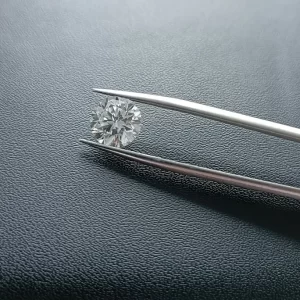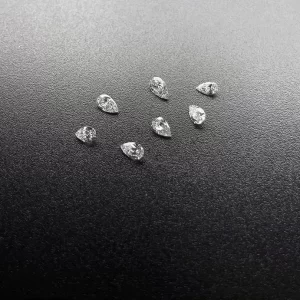2 Carat 3 Carat Fancy Cut Lab Diamonds CVD Cushion Cut Diamonds
2 Carat 3 Carat CVD Cushion Cut Fancy Cut Lab Diamonds For Making Lab Created Diamond Rings
Fancy Cut Lab Diamonds Description
Lab diamonds are real diamonds. Carbon is the main element of natural and laboratory-grown diamonds. The chemical and physical properties of synthetic diamonds are same as natural diamonds in terms of hardness, thermal conductivity, and strength. After polishing it’s difficult to distingush lab diamonds and natural diamond by naked eyes.
Round cut is the most common cut. Fancy shaped lab diamond, also known as gardener cut diamond, refers to diamonds other than standard round diamonds. The common fancy shape lab diamonds include pear shaped, marquise shaped, princess, radiant, emerald cut, heart, oval shape, etc.
Cushion cut was popular from the 19th century to the 20th century. Cushion diamond cut has 58 facets, which is the predecessor of brilliant cutting. Since 1830, diamonds have been used for nearly a century, and only this kind of cutting is used, including many world-famous diamonds.
The unique shape of diamond cushion has been popular for more than a century. The four round corners and wider facets increase its brightness. Therefore, when selecting Si level clarity, you must check the clarity column on the certificate.
Cushion Cut Diamonds
If you are looking for the perfect engagement ring, then you have probably considered purchasing a Diamond Cushion. Cushion diamonds are an excellent choice because of their shape, color, and price. Learn more about this shape and how they are created by a laboratory. You can find more information about the different kinds of Cushion cut diamonds at our website. It’s easy to compare them to other diamond shapes, but you may want to know which one is best for you before making a purchase.
HPHT Cushion Cut Diamonds
While there are several diamond cutting processes, the production of gem-quality lab-grown diamonds is not as straightforward as that of natural diamonds. Unlike natural diamonds, which are mined from the seeds of sapphires or opals, lab-grown stones are formed from tiny seeds. The seed carries with it certain characteristics that will be transferred to the newly formed stone. The result is a high-quality stone. However, lab-grown diamonds need to be purchased with caution. The price of such diamonds fluctuates based on the 4C’s.
A lab-grown cushion diamond has an identical chemical composition and appearance to a mined diamond. It also has the same carat and clarity grades. Its slender pavilion and lesser hidden weight are two key features of premium cuts. The shape of these stones enables them to hide the presence of more inclusions and still make the stone appear elegant and sparkly. These diamonds are therefore ideal for engagement rings.
A significant difference between natural and lab-grown diamonds lies in their origin. Lab-grown diamonds are created in controlled environments with lower carbon emissions and use significantly less water than mined diamonds. Earth-created diamonds are a classic choice for engagement rings and other fine jewelry. However, if you want something more modern, you should consider buying a synthetic diamond. It’s worth noting that diamonds can also be created in different shapes, including fancy shapes and emerald and princess cuts.
High-pressure, high-temperature (HPHT) and CVD are two different diamond growing techniques. While HPHT replicates the natural conditions that occur in diamond-growing, CVD uses a lower pressure environment and a vacuum chamber to grow the stone layer by layer. The result is a ring with a diamond of up to one carat in weight and near-colorless grade.
If you’re looking for an eco-friendly and ethical way to purchase a diamond, synthetic lab-grown diamonds are a great alternative. These diamonds are created under the same conditions that natural diamonds do and have virtually no flaws. HPHT and CVD processes create diamonds with the same chemical properties as natural diamonds. Both processes require the use of a small synthetic diamond seed and carbon source.
Shape of Cushion Cut Diamonds
If you are interested in purchasing a cushion diamond, you should be aware that the shape varies from round to elongated. The ratio between table size and length of a cushion cut is generally in the range of 1.10 to 1.20. The classic pillow shape has more angles than other diamond shapes, making it a popular choice for engagement rings and other heirloom items. However, you should remember that the ratio between table size and depth is a matter of personal taste and preference.
The carat weight is another factor in selecting a diamond. The higher the carat weight, the more expensive the diamond. A smaller diamond can be made to look larger by adding a halo. Buying a cushion cut diamond from a lab can save you between 20 and 30% of the price of a comparable cut and quality. A lab-grown diamond with higher carat weight is a better choice for engagement rings because it will be a more luxurious choice than a smaller stone.
One carat cushion cut diamond will cost approximately $3,500. A set of prongs for a cushion cut diamond can cost anywhere from $500 to $1500. This is a significant savings when it comes to diamond jewelry, but it will lower the beauty of the stone. However, it is possible to find lower-grade cushion diamonds. In such cases, you should opt for custom-made engagement rings.
The shape of Cushion Cut Diamonds in fancy cut labs is the perfect combination of old mine cuts and modern round brilliant cuts. Cushion cut diamonds are typically cheaper than round brilliant diamonds because the demand for them is lower. A cushion cut diamond is also more affordable than round diamonds, and you can save between 15 and 20% by choosing a cushion cut. They have excellent fire and light scintillation. A cushion cut diamond is a versatile design that will look beautiful in many settings.
A cushion cut is also known as a pillow cut or candlelight cut. It is a squarish shape with rounded corners. It is among the oldest of all diamond cuts. Cushion cut diamonds can be found in a wide variety of facet arrangements, but are not necessarily better. As with any cut, you should seek the advice of an expert in the field before making your final selection.
Color of Cushion Cut Diamonds
One of the most popular shapes of diamonds is the cushion cut. It has an antique look with rounded corners, which is popular with vintage-style engagement rings. Cushion cuts are available in various carat weights and proportions. Because of their elongated shape, they can have a higher carat weight than square cushion cut diamonds. Similarly, the cost of elongated diamonds may be lower than square cushion cut diamonds.
A cushion-cut diamond may have rounded corners and slightly curved sides. The shape is not reported in a lab report, so the buyer should take the help of a professional when purchasing a diamond. James Allen sells three extreme cushion shapes and advises searching for diamonds with a table and depth percentage below 70%. The best way to find these diamonds is by watching videos of them to determine whether they are right for you.
A square diamond is often better for engagement rings because it will show off the ring’s girdle better. However, elongated diamonds will often be yellower than their square counterparts. To avoid yellow cushion diamonds, look for a diamond with a color grade of H or higher. This will help ensure that the diamond you choose is of high quality. A cushion cut diamond may have an awkward zone in the L/W proportions, but this shouldn’t be a problem.
As with any gemstone, a cushion-cut diamond can have inclusions. Clarity refers to the size and number of blemishes. Each diamond has different flaws. SI2 diamonds are the most flaw-prone, while VVS1 diamonds are the least. The cushion-cut diamond’s shape and clarity help to hide most flaws. A square cushion diamond has fewer inclusions, while a crushed-ice-facet style is more likely to have inclusions.
Cushion diamonds are often more affordable than round diamonds. The price difference may be significant depending on the 4Cs and quality. A 2 carat cushion diamond with an H color and VS2 clarity will cost just $7,000 compared to a similar size Round Brilliant. The girdle is the perimeter dividing the crown from the pavilion. Cushion diamonds also tend to have higher table sizes than round diamonds due to their intrinsic facet structure.
Price of Cushion Cut Diamonds
When it comes to buying a diamond, the higher its grade, the more expensive it will be. While a 1 carat F/VVS2 cushion cut diamond will cost about $5470, a 1/2 carat H/SI1 should cost between $700 and $1000. A 2 carat H/SI1 cushion cut diamond should cost around $17,000. But remember that beauty is more important than price.
Cushion cut lab diamonds are gaining popularity in recent years. Their brilliance and fire are attracting many modern women, and their cost is less than that of a standard round brilliant cut. They are also ideal for a classic, vintage look. The best place to find a cushion cut diamond is Diamonds Direct. Here are some tips to help you choose the perfect diamond. If you’re considering purchasing a cushion cut diamond, here are some tips:
First, consider the carat weight. As the name suggests, a bigger carat equals more beauty. The larger the carat weight, the higher the price. This is particularly important for engagement rings, as bigger diamonds are more desirable than smaller ones. However, the price difference between a small cushion cut diamond and a large fancy cut lab diamond can be quite substantial. It is important to know that a higher carat weight does not necessarily mean a larger diamond.
Size and clarity also play a big part in the price of a cushion cut diamond. If you want the perfect diamond for a special someone, you should opt for a larger carat diamond. It will cost you much less, but will be less beautiful than a smaller diamond. However, the larger diamond will probably ship from Beverly Hills, CA. A high quality cushion cut diamond will also be worth its weight in gold.
2 Carat 3 Carat Fancy Cut Lab Diamonds CVD Cushion Cut Diamonds

















